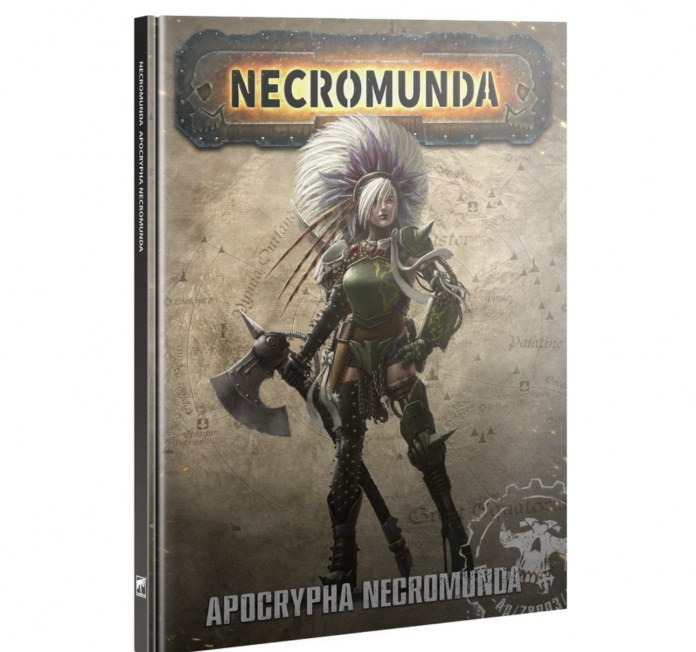Welcome to the Goonhammer “roundtable” for the new Apocrypha book! We say new, but a lot of this stuff is collected from previous, mostly White Dwarf, rules releases, or brought over from the Dark Uprising set. There is some new content centered around fleshing out campaigns with narrative-derived rules, and the book holds the Delaque unique crew and vehicle tactics (but no actual unique vehicle).
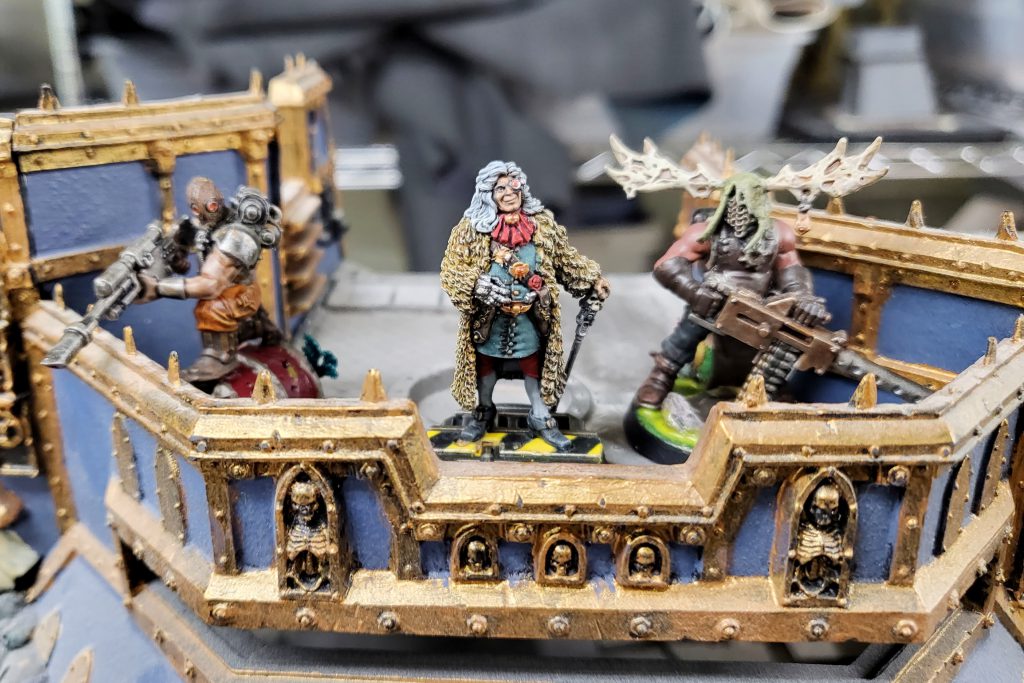
Underhive Nemesis
Genghis Cohen: This is one of the genuinely new bits and a nice template for Arbitrators to essentially create villains for their campaigns. In our experience that’s a fairly common storytelling construct for Necromunda – some crime lord, powerful madman or tyrannical Guilder is driving the narrative and providing an antagonist, or sometimes dubious ally, for the gangs taking part. The rules urge Arbitrators to select from one of 3 Archetypes – Warrior, Schemer and Overlord, which all come with a selection of profiles (which vary but are all rather better than a starting Gang Leader) and several Primary Skill sets. All those archetypes have suggestions for theme and background, and that narrative side is expanded by picking a Motivation, Connection (ie to a certain type of power base) and Weakness for each nemesis – those categories are purely narrative.
Narrative play is really at the forefront here. Arbitrators can pick basically any equipment, skills, Wyrd powers etc for their created Nemeses and it’s explicitly stated that if they want to change any stats or skills, or introduce House-exclusive rules to better represent a concept, that’s fine. They also introduce the concept of Hive Minions – feel free to create some fighters, picking anything appropriate from any book, and they will follow your Nemesis around (their credit cost counts as part of the big guy’s equipment for Threat Rating, see below). With all the stuff available in current Necromunda the sky is truly the limit for what Arbitrators can come up with.
There is a Threat Rating system where a Nemesis starts at 5, and every additional skill, Wyrd power, or lump of credits spent on equipment raises that Threat Rating. There is a suggested maximum Threat Rating that a Nemesis should have for a given size of gang taking part in the campaign. For example if the average Gang Rating is 2000-2499 credits, Max Threat Rating is suggested as 15. In my opinion this is the weakest or most unnecessary part of a very cool set of rules. It is trying to slap arbitrary numbers and limits on what is a very fluid concept, and like most Necromunda points-cost balancing, it’s no more than a finger in the air. Honestly if I was arbitrating I might calculate my Nemesis’ total Threat and see where it ended up, but I wouldn’t trust this system to make balance decisions about whether the campaign gangs could handle facing it in battle, I would be much more likely to judge that by ear, maybe calculating the credit cost of equipment and minions, then adding a guessed value for the Nemesis profile and any skills added.
Fowler: My campaigns tend to have a big bad pulling the strings in the background, though they rarely make it on to the board and fight. I agree that the numbers may need a tweak to be better balanced on the battlefield, but I can see myself giving this system a shot to simplify the process of making an antagonist, as well as to give them an active role on the tabletop.
Living Settings
Fowler: It’s nice to see GW nudge arbitrators to have extremely fleshed out settings. Similar to the above’s character generation, this is a toolkit for creating a detailed backdrop for a campaign. The best settings are lived in, vibrant, and have plenty of hooks for more potential mayhem. If coming up with a backdrop all on your own sounds daunting, they also provide plenty of homework to cheat off of. Detailed rundowns of in-lore settlements like Sump City and Dust Falls round out the section, showing off what a fully operational setting can look like.
Resurrection Packages
Fowler: You can check out our previous coverage on resurrection packages here. The elevator pitch – this is a rule framework for bringing back a dead ganger. THERE IS A COST! Every method of resurrection has a major drawback. A Debt of Blood brings an immediate alliance to the table, but with an immense cost; continued survival requires a friendly ganger to be sacrificed every turn… until the returned fighter turns themselves in.
I gave out resurrection packages pretty freely in my last campaign, here are some thoughts:
- Only offer to gangs in the bottom half of the standings
- Each gang is very limited in terms of how packages they can receive
- Mostly gave out Revenant
This set up some very spicy rematches, including a revenant-on-murderer duel that ended in success (and immediate evaporation). Especially if you are trying to foster a strong narrative element to your campaign, resurrection packages can spark some serious rivalries.
Arbitrator Scenarios
Fowler: We will go further in-depth on these scenarios in a future article. The short version here is that these are familiar missions, with extra narrative twists. Prison Break is a modified rescue mission; but now instead of trying to reclaim a captured fighter from a rival gang, the target is being held by a (potentially) arbitrator-piloted guilder caravan. The fresh options look interesting, but at the end of the day these feel like remixes.
Gang Raid Scenarios
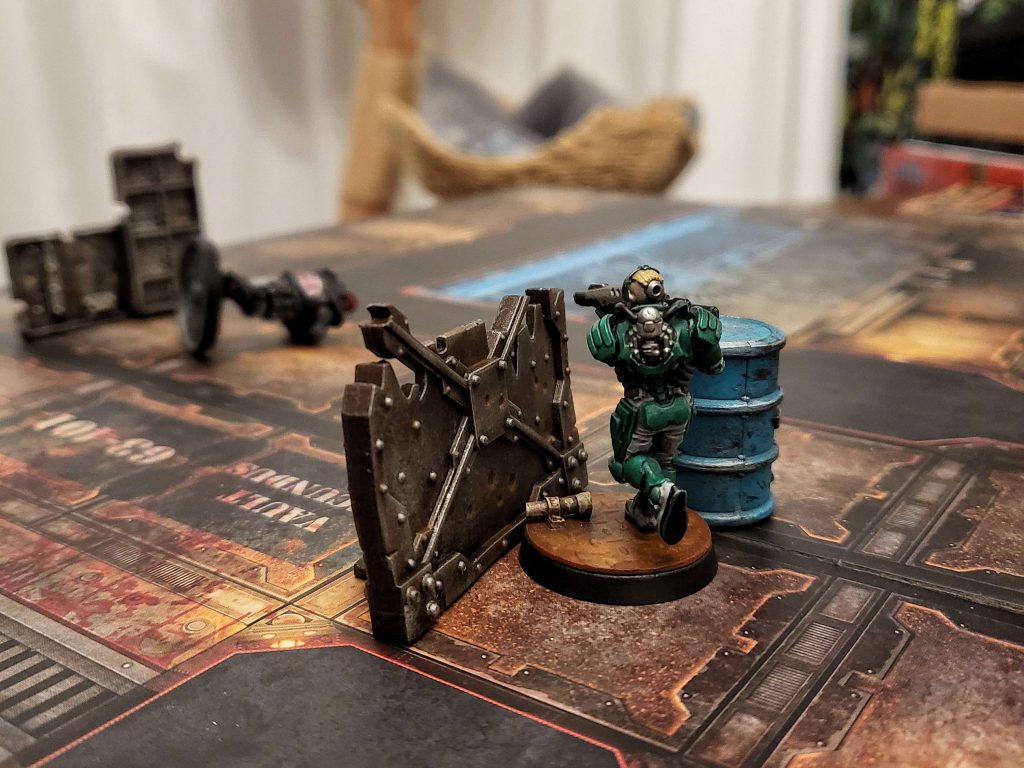
Fowler: Originally released in White Dwarf in 2019, Gang Raids are bite-sized missions that you can (theoretically) knock out in as little as a half an hour. In my last two campaigns, Gang Raids made frequent appearances. They are a fantastic foil for late opponents, surprisingly short games, and sorely needed recovery re-sets. Gangs leave their leaders at home, and can only take along one champion. Daylight Robbery is an asymmetrical escape scenario – the attacker attempts to move a stash marker across the map, through the defender. My experience with this mission is that it absolutely never goes to plan, with hilarious results.
Another highlight is Bar Brawl, which is exactly what it says on the tin. Inebriated gangers (and NPC patrons) have an old-fashioned donnybrook. No guns, no grenades, no unwieldy melee weapons, just sticks and fists. This scenario is a great pick for downtime shenanigans, or if you want to throw something a bit lighter at your campaign. There isn’t a whole lot going on with this mission, which makes it a prime candidate for customizing. It scales up as a multiplayer scenario as well.
Overall, Gang Raids are a fine addition to the arbitrator’s toolkit; perfect for sneaking in an extra game while you still have models out and a table set up! As all the Gang Raids are meant to be played on Zone Mortalis, they take up less space, too! Very cool to see these rules become gettable again!

Uprising Campaign
You can check out our previous coverage of the Dark Uprising campaign here.
Genghis Cohen: I like the Uprising Campaign, but not some of the scenarios. Show of Force is just lopsided in favour of the Attacker for no real reason. Not only do they get more and custom-picked fighters, in the Insurrection phase they get big credit rewards for taking out enemies while the outnumbered defenders get nothing. Hit and Run suffers from the same problem, although not quite as unequal. Search and Destroy is just brutally slanted toward the attacker, who starts with Custom (10) Crew to the Defender’s Random (D3+3). Scavenge is a nice equal fight with a fun objective (opening loot caskets) although the rules for players placing those caskets require a bit of goodwill and sportsmanship on both sides. Meat Harvest and Public Execution are at least both very thematic narrative scenarios, although maybe a little much for an easy pickup game night.
Merton: One of the benefits of a reprint is that we’ve already hashed out the Uprising Campaign, so go check out what we had to say when it first debuted. It was pretty neat then, and it’s still a solid change of pace from your normal Dominion variant. Plus, if your group somehow managed to avoid accruing an entire motor pool’s worth of vehicles from the past year’s Ash Waste scenarios, it’ll be nice to get back to exclusively underhive.
The campaign itself is definitely worth a play, though there’s definitely a tonal shift from the buckets of credits everyone was splashing around in Cinderak. Fighters are weak and starving, the scenarios are sadistic (happy to play Meat Harvest, but Show of Force on the mission table? Jeez), and you’ll rarely find what you need on your Scavenge rolls. It’s fantastic to have this campaign available to folks who aren’t avid ebay-hounds, and Arbitrators will definitely want to work it at least once. Maybe shorten the amount of campaign weeks, though, it can be hard for gangs to virtually compete at all if they take some bad losses early on.
If you have played around with Uprising before, there’s not much difference to the campaign rules or the scenarios that were printed in the box book (or in Book of Ruin). There are some wording adjustments to better jive with the new Core Rulebook and Scavenge is on the mission table, but it’s largely the same. Nobody gets +1 XP simply for being a participant in a battle anymore, but it seems that that reward has been excised from all scenarios printed since the new rulebook.
Outlaw Brutes
Scrapcode-Corrupted Ambot
Genghis Cohen: Better WS and A than a normal Ambot? 220 credits, only a fool would take the grav-fist upgrade for 90 credits; heavier carapace is very marginal at 55 credits and armour spikes also rather pointless for 15 credits.
Mutated Ogryn
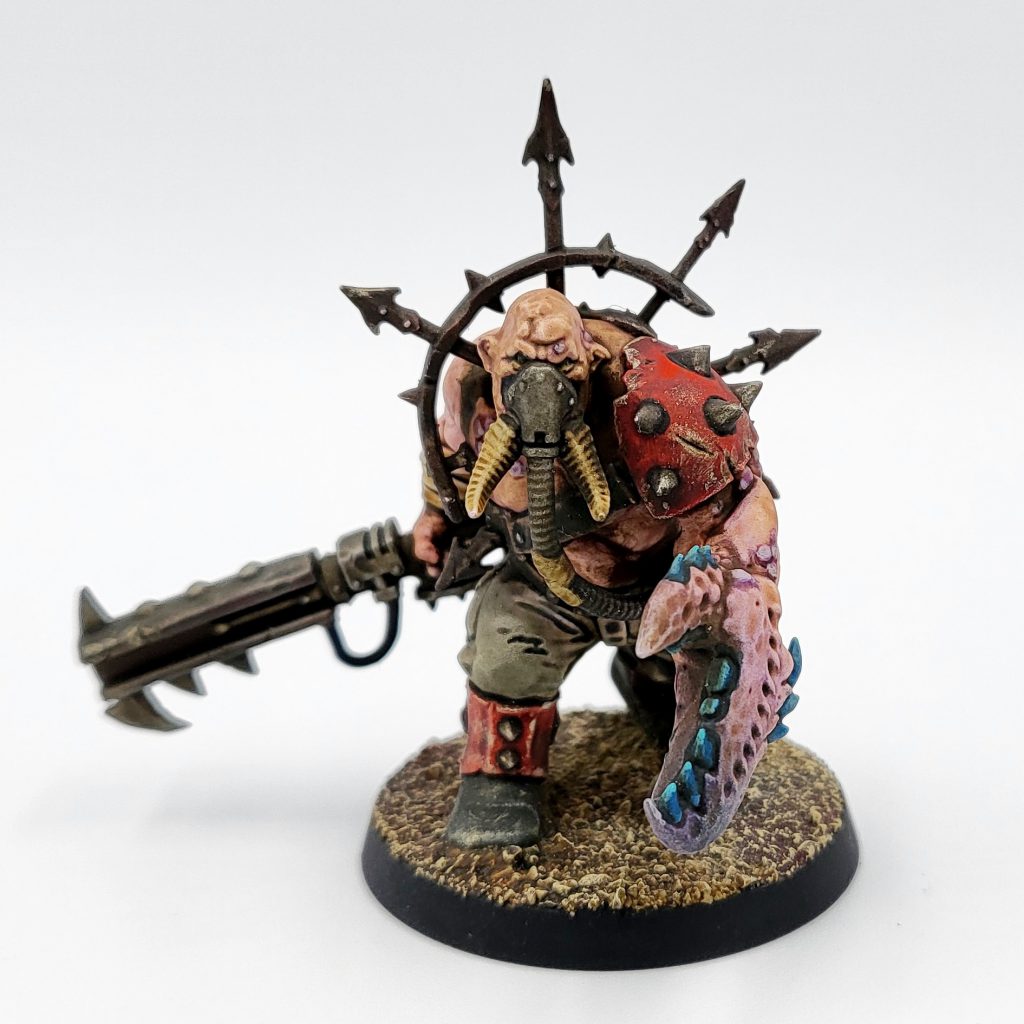
Genghis Cohen: 210 credits and actually very comparable in stats to the Scrapcode Ambot, but is unarmoured with a far lighter upgrade option in Furnace Plates (a steal for 15 credits). Players would definitely want to pay 20 credits to upgrade one of its crappy Open Fist melee weapons into a Horrific Appendage for improved Damage. The Power Maul is more debatable at 30 credits (you can replace either fist with one upgrade option, you can’t take two of the same). True Grit is a nice enough starting skill and it gets one random pick from Ferocity or the Corpse-Grinder exclusive Savagery tree (we would take Ferocity, as it’s more consistent). Pray you get Nerves of Steel we guess! Overall a scary melee threat but not quite as good value as the Scrapcode Ambot.
Sump Beast
Genghis Cohen: another choice in the same price band at 200 credits, the Sump Beast has a choice of 3 profiles, all fairly scary and in line with the other melee-focussed Brutes. The thing is that its starting melee weapon isn’t that impressive – most players would either pay 70 credits for the much punchier Crushing Claws or 50 credits for a Lashing Tail, which doesn’t hit any harder but has a 6” Versatile range – excellent for catching your opponents out. It’s also hard to argue against taking Multiple Legs (+2” Movement and the Clamber skill for 20 credits) or Scaly Hide (a 4+ armour save for 40 credits). The budget-conscious among you will see the problem though, all these costs are starting to add up!
Although it does start with True Grit, Unstoppable and Fearsome for free, we’re not sure this beastie is worth it against the competition, especially as it comes with a very dangerous special rule: if there is a Seriously Injured fighter within 6” of it when it Activates, it must pass an Intelligence check (on a 9+ or 10+ depending on the profile chosen) or spend its actions charging and Coup de Gracing that fighter. This applies to friends and foes alike. If you think about most Necromunda games, the constraints of space, how your fighters generally start closer to each other than the enemy . . . you are going to need to be quite careful to stop this Horror running out of control and potentially really messing things up.
Warp Horror
Genghis Cohen: clocking in at 210 credits (there really is a competitive pricing market for outlaw brutes isn’t there?), this option features a really excellent close combat punch, especially given it starts with 6” Move and Nerves of Steel, but it’s a little squishier than the others at T4 (but still 3W) and no armour. It has a minor weakness in a chance to gain a Flesh Wound in the end phase – but that is based on 2D6 equal to or lower than the round number, so it has a tiny chance to kick in on Round 2 and a very low chance to kick in until at least Round 4-5, so most games will be resolved by the time that makes a difference. Against that, it is Terrifying – enemies must make a Willpower check before fighting or shooting against it, losing their whole Activation on a failure, and it ignores all Lasting Injury results except Memorable Death. Honestly that last bit is a pretty big deal – it may not be as resilient as some Brutes, but if it does go Out of Action, unless you’re very unlucky there won’t be any long term consequences.
A Warp Horror can, uniquely for a Brute, be upgraded between games after its initial recruitment, representing it mutating. Massive Tentacles (50 credits) give it an alternative melee weapon, which isn’t that great at tackling anything with armour or multiple wounds, but does have a 4” Versatile range. Warpfire Breath is literally a hand flamer, for 90 credits. Either of those are debatable, they expand the Horror’s threat radius considerably but it sort of does one thing, charging into combat and pasting enemies, rather well, so why pay big bucks for an alternative? Undulating Skin, on the other hand, seems like an auto-take for 40 credits, since it reduces the Damage of any hit suffered by 1, to a minimum of 1. That’s a very strong ability on a 3W model.
I don’t want to get too far into ‘which Brute is best’ in this roundtable, but they all bring some sort of scary melee threat. What jumps out at me, as with all Necromunda rules really, is just how much the credit costs seem to have been picked at random. Upgrading normal light carapace armour to heavy carapace is +20 credits, the Scrapcode Ambot pays 55. Fair enough, it’s a meaty brute, they want you to pay more to up-armour it . . . except the otherwise very comparable Mutated Ogryn starts with no armour at all, so I guess the Ambot’s starting armour was free? Then you have the Sump Horror buying a 4+ save for 40 credits, where buying equivalent light carapace armour for most models costs 80. It’s not that items aren’t priced consistently with their value, there will always be winners and losers on that front (we would have a lot less to write about otherwise). It’s that upgrades aren’t even consistently priced against other upgrades which do the same thing! Drives me mad.
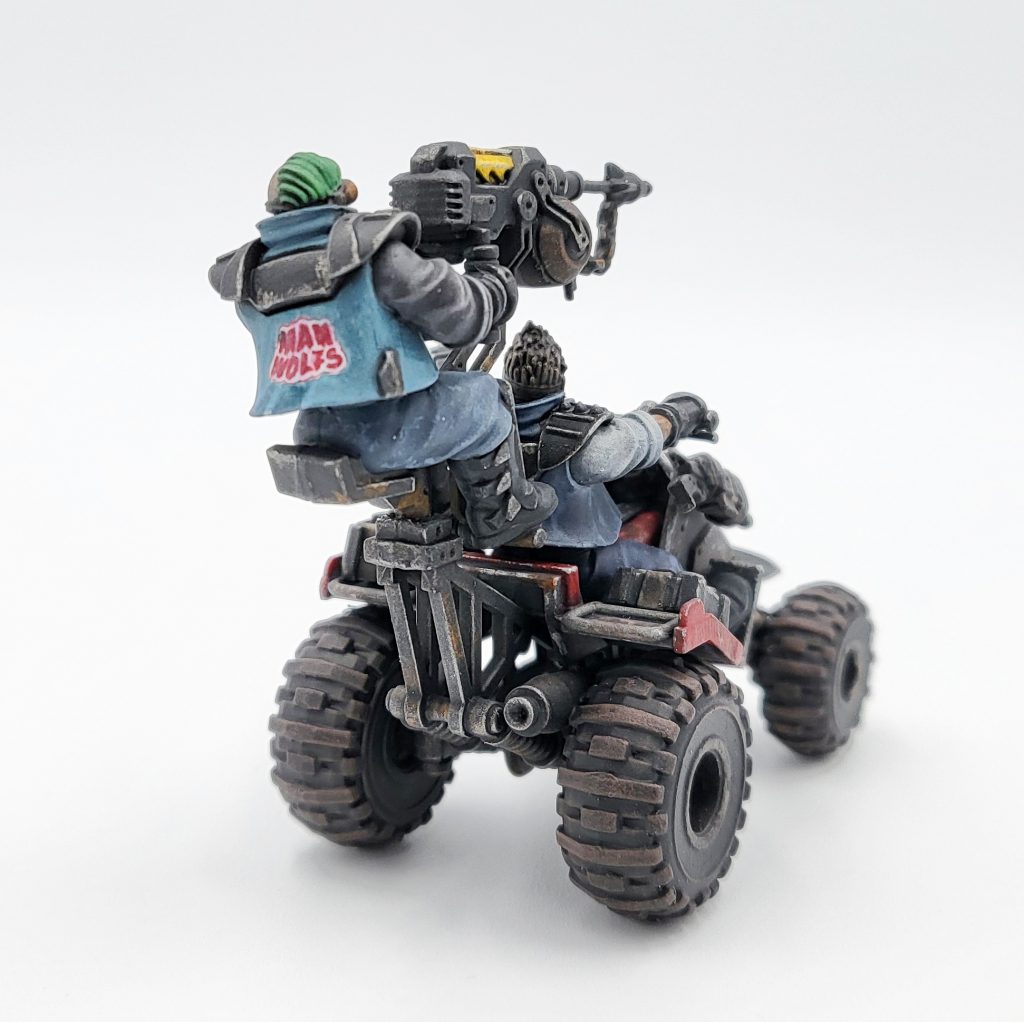
Additional Clan House Vehicle Rules
Genghis Cohen: This was actually the heading I was most excited to see in the table of contents and I flipped straight to it. Honestly, rather disappointed. This is a list of weapons and wargear which each Clan House can access on all their vehicles. But the Wargear is all weapon accessories – sights, hotshot las packs etc.
Players could always add any Trading Post-bought weapon to any vehicle, and my understanding is there was nothing previously stopping a player buying, say, a Telescopic Sight from the TP, adding it to their Stash, then subsequently slapping it onto a vehicle-mounted weapon anyway. So these rules mostly just allow such additions at Gang Creation, and/or without rolling to seek rare equipment. The one concrete change I can see is that gangs’ faction-exclusive weaponry, like the Cawdor heavy crossbow or Goliath ‘krumper’ rivet cannon, can now be added to their vehicles. Which is nice.
My negativity here comes from what they didn’t put into these House vehicle lists. No vehicle Upgrades or vehicle-specific wargear. The latter is minor, sure, since all vehicles can add any vehicle wargear from the TP. But Upgrades are restricted to set lists for all the non-custom vehicles. This was a perfect opportunity to add 1-2 thematic Upgrades to every gang’s list – Van Saar getting the ability to make anti-grav vehicles is the obvious example. Perhaps that was considered too vulnerable to exploitation.
Primaris Kevin: This pretty much enables people to do half of what they were already doing; Most campaigns would let players do something like add anti-grav plates to their vehicles if they were already modelled with it. At least this now lets me give Archeoteks multi-meltas at gang creation.
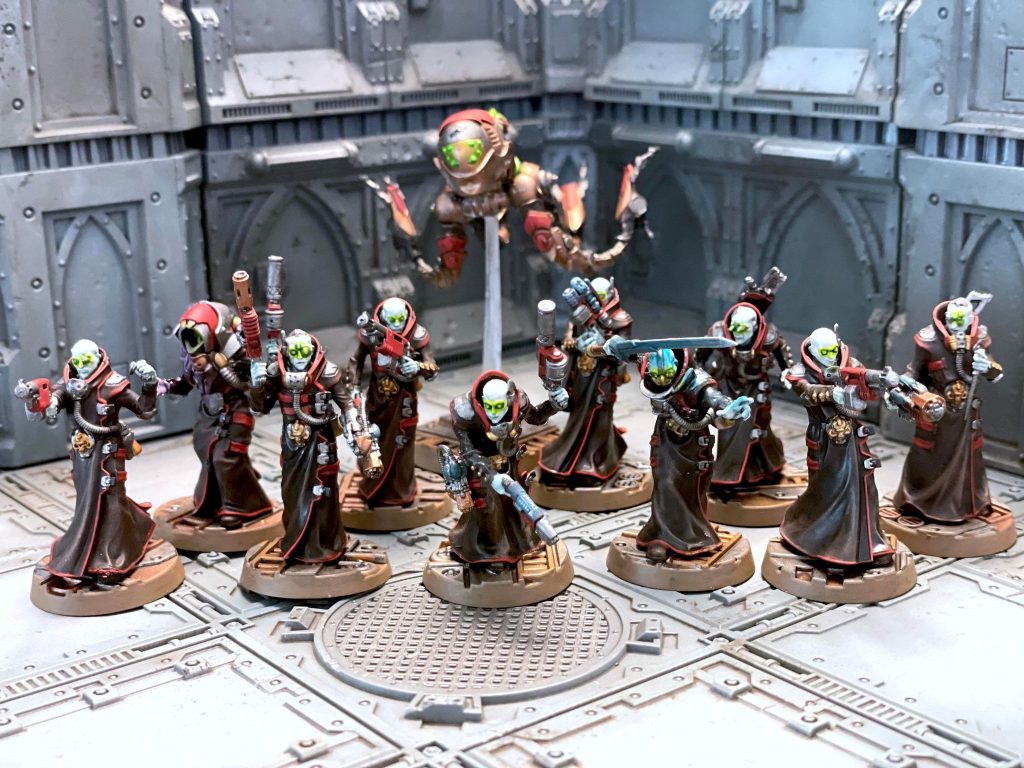
Delaque Wraith & Vehicle Tactics
Genghis Cohen: No vehicle for you!
The poor Delaque do not yet receive a unique vehicle kit. Their unique Crew, the Wraith, is bog standard – 4+BS, 6+ Cool for 35 credits, with the normal access to custom and preset vehicles, they also get Delaque’s flechette pistol and 5pt autopistol options, neither of which will be common choices for vehicle crews.
Their vehicle tactics are (as you might expect) themed around being sneaky, with some interesting ones allowing Mounted fighters to gain full cover or Hidden status after moving, and perhaps the strongest tactics are the ones that allow redeployment of D3 vehicles, or a quasi-infiltrate on one vehicle. Definitely the funniest, though, and certainly the most hilarious and potentially abusable, is Hallucinogenic Fumes, which for one Activation makes any fighters (friend or foe) who were within 1” of the activated vehicle at any point, test Willpower or go Insane! Broad good news though in that an initial read-through doesn’t show any particularly broken or salt-generating tactics. The cards which do have potentially powerful effects have specific circumstance triggers on them.
Merton: It is madness that Delaque do not get a vehicle. They’re a house gang, and they get snubbed in favor of what, the lawbots? Enforcers somehow wound up with more plastic kits than any other faction, and they’re still running off of a book that’s functionally an edition behind.
I could see it if this ended up being similar to the last time Delaque was seemingly overlooked, where they didn’t get a Gang War book but Gangs of The Underhive came out a few months later anyway and made everything right. Though if that’s the case, why not just drop it here in Apocrypha? Necromunda’s never had an issue with rules long preceding their official models, not for brutes or bounty hunters or even vehicles, most recently seen with the Tauros Venator not being ready to be shown off in Ruins of Jardlan. There’s plenty of page space. Madness!
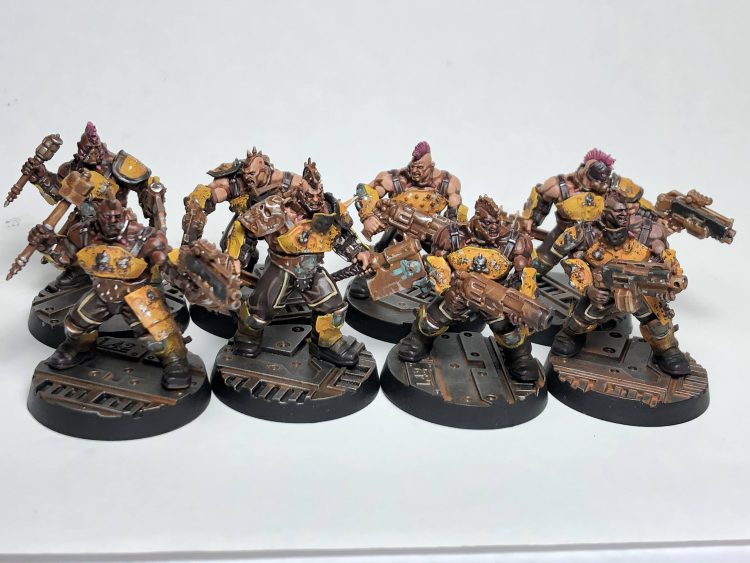
Conclusion
Merton: I’ll start with the upside to Apocrypha Necromunda. The Nemeses and Living Setting rules are a fun jumping-off point for Arbitrators to really delve into becoming storytellers, instead of merely bookkeepers. There are myriad possibilities for campaigns when you can get your players thinking about their roles in the underhive as a whole, and not just how they’re going to spend their next 2d6x10 credits. These aren’t the most mechanically intricate systems, but they don’t have to be! All you need is the spark, with gameplay rewards/consequences or not, and the story can build from there.
Merton: I can’t help but be discouraged by a hardcover release that devotes the remaining 80% of its pages to reprinted material. We’ve got some leftover scenarios from the Gang War books, some White Dwarf articles and pamphlets, and a box set campaign. There’s not really anything in here that’s a must-have to an average player, moreso for an Arbitrator who wants a few new(ish) tricks and missed out on them the first time around.
That’s kind of been the entirety of 2023, though, isn’t it? The Succession books were a new model or two, a new campaign would seem suspiciously familiar aside from the macguffins, and the same selection of scenarios with the serial numbers filed off. Now that we’re through all of those, we get a book that has no models, a couple of Arbitrator tools, and a bevy of old rules that we can once again purchase directly from GW instead of resorting to the dreaded secondary market.
Fowler: A collection of the Warcom Apocrypha PDFs in a book would be fantastic. It’s still kind of wild that the rules but with the sump setting is digital only!
Merton: Looking back at the year as a whole, I can’t say that I feel like I saw a lot of innovation or excitement out of the Necromunda releases, especially on the heels of the revised rulebook back in June. Finishing everything off with a book that really does little more than let us Buy It Again is disappointing, and I sincerely hope that 2024 is better.
Also for the love of god, give Nomads more bugs please.
The Apocrypha is chock full of rules, we just wish more of them were new! This book clearly has some high points, but it retreads a significant amount of ground. As always, if you have any questions or suggestions, drop us a line at Contact@Goonhammer.com.
